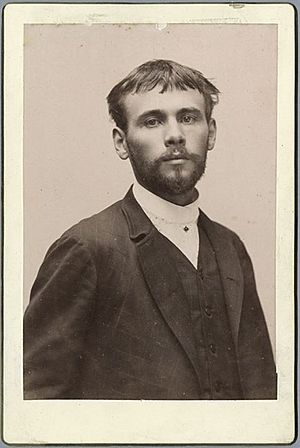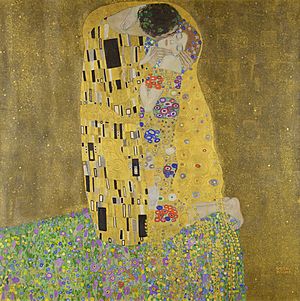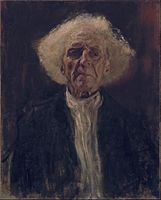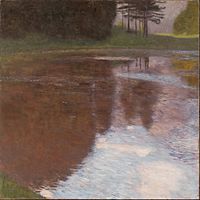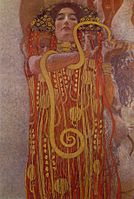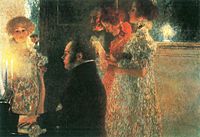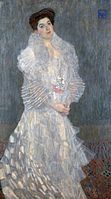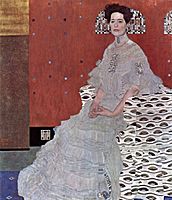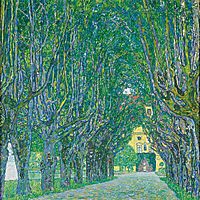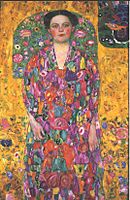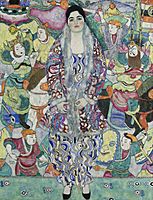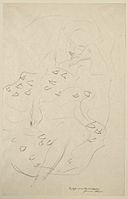Gustav Klimt facts for kids
Quick facts for kids
Gustav Klimt
|
|
|---|---|
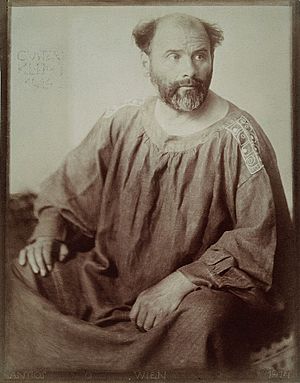
Photographic portrait from 1914
|
|
| Born | 14 July 1862 Baumgarten, Austrian Empire
|
| Died | 6 February 1918 (aged 55) |
| Nationality | Austro-Hungarian |
| Known for | Painter |
|
Notable work
|
Judith and the Head of Holofernes, Portrait of Adele Bloch-Bauer I, The Kiss, Danaë |
| Movement | Symbolism, Art Nouveau, Vienna Secession |
| Partner(s) | Emilie Louise Flöge |
Gustav Klimt (born July 14, 1862 – died February 6, 1918) was a famous Austrian painter. He was a leading member of the Vienna Secession movement, a group of artists who wanted to show new and different art. Klimt is well-known for his paintings, murals (wall paintings), and sketches.
Early in his career, Klimt painted decorations for buildings in a traditional way. Later, he became very successful with his "golden phase" paintings. Many of these artworks use real gold leaf, making them shine. Klimt's unique style also influenced other artists, like his younger friend Egon Schiele.
Life and work
Early life and artistic beginnings
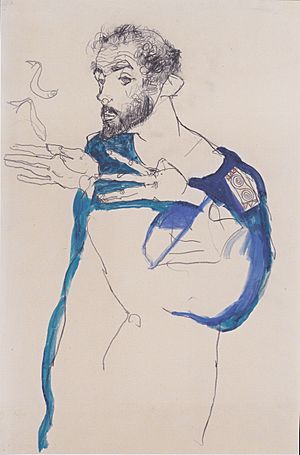
Gustav Klimt was born in Baumgarten, a town near Vienna in the Austrian Empire. He was the second of seven children. His father, Ernst Klimt the Elder, was a gold engraver. All three of the Klimt sons showed artistic talent from a young age.
Klimt studied architectural painting at the Vienna Kunstgewerbeschule, a school for applied arts and crafts. He attended from 1876 to 1883. During this time, he lived in poverty. He admired Hans Makart, a famous history painter in Vienna.
In 1880, Gustav, his brother Ernst, and their friend Franz Matsch formed a group called the "Company of Artists." They received many jobs together. They even helped their teacher paint murals in the Kunsthistorisches Museum in Vienna. Klimt started his career painting murals and ceilings in large public buildings.
In 1888, Emperor Franz Josef I of Austria gave Klimt an award for his work on murals in the Burgtheater in Vienna. Sadly, in 1892, Klimt's father and brother Ernst both passed away. Gustav had to help support their families financially. These sad events also changed his artistic ideas, leading him to develop a new personal style.
Around the end of the 19th century, Klimt often included a figure called Nuda Veritas (meaning "naked truth") in his art. This figure symbolized truth and honesty. Historians believe Klimt used this figure to show problems in society and politics at the time.
In the early 1890s, Klimt met Emilie Louise Flöge, a fashion designer. She became his lifelong companion. His famous painting, The Kiss (1907–08), is thought to show them as lovers. Klimt also designed many costumes that Emilie produced and wore in his artworks.
Vienna Secession movement
In 1897, Klimt became one of the founders and president of the Wiener Sezession (the Vienna Secession). He also helped with their magazine, Ver Sacrum ("Sacred Spring"). He stayed with the Secession group until 1908.
The group's main goals were to:
- Show the work of new and different young artists.
- Bring the best art from other countries to Vienna.
- Publish their own magazine to show members' artwork.
The Secession group did not have one specific style. Artists who painted in naturalist, realist, and symbolist styles all worked together. The government even supported them and gave them land to build an exhibition hall. The group's symbol was Pallas Athena, the Greek goddess of wisdom and arts. Klimt painted his own unique version of her in 1898.
In 1894, Klimt was asked to create three paintings for the ceiling of the Great Hall at the University of Vienna. These paintings, Philosophy, Medicine, and Jurisprudence, were finished around 1900. However, they caused a lot of debate because of their new and bold themes. Many people, including politicians and religious leaders, criticized them. Because of this, the paintings were never put on display at the university. This was the last time Klimt accepted a public art job. Sadly, all three paintings were destroyed in 1945 when German forces burned Schloss Immendorf.
In 1902, Klimt completed the Beethoven Frieze for an exhibition celebrating the composer Ludwig van Beethoven. This large artwork was painted directly on the walls. It was meant only for the exhibition. However, it was saved and later restored in 1986. The face in the Beethoven portrait looked like Gustav Mahler, a famous conductor.
During this time, Klimt also painted many landscapes. He spent his summer holidays with the Flöge family by the Attersee lake. These landscapes were the only type of painting, besides people, that truly interested him. Locals even called him Waldschrat ("forest demon") because of how focused he was. Klimt's landscapes often flattened the sense of deep space. Some believe he used a telescope to paint them.
Golden phase and success
Klimt's 'Golden Phase' was a time of great success and positive reviews for him. Many of his paintings from this period used gold leaf. Klimt had used gold before in Pallas Athene (1898) and Judith I (1901). But the most famous works from this time are Portrait of Adele Bloch-Bauer I (1907) and The Kiss (1907–08).
Klimt did not travel much. However, trips to Venice and Ravenna, known for their beautiful mosaics, likely inspired his use of gold and Byzantine-like images. In 1904, he worked with other artists on the grand Palais Stoclet. This was the home of a rich Belgian businessman and a major example of Art Nouveau design. Klimt's work for the dining room, including Fulfillment and Expectation, were some of his best decorative pieces. He said they were "probably the ultimate stage of my development of ornament."
In 1905, Klimt painted The Three Ages of Woman, which shows the different stages of life. He also painted a portrait of Margarete Wittgenstein, the sister of a famous philosopher. Between 1907 and 1909, Klimt painted five artworks of women in society wearing fur. His love for clothing is clear in the many photos of Emilie Flöge wearing his designs.
Klimt lived a simple life, focused on his art and family. He usually wore sandals and a long robe at home. He avoided social gatherings and rarely spent time with other artists. Because of his fame, people often came to him for paintings. He could choose his clients carefully. His painting method was very careful and sometimes took a long time. His subjects had to sit for many hours.
Klimt did not write much about his art or ideas. He mostly sent postcards to Emilie Flöge and did not keep a diary. In a rare note, he wrote: "I have never painted a self-portrait. I am less interested in myself as a subject for a painting than I am in other people, above all women... There is nothing special about me. I am a painter who paints day after day from morning to night... Whoever wants to know something about me... ought to look carefully at my pictures."
Death and tributes
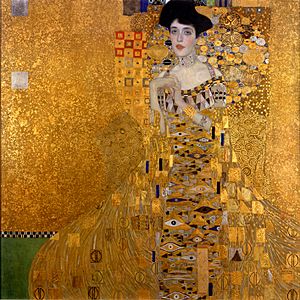
In 1911, Klimt's painting Death and Life won first prize at an art exhibition in Rome. In 1915, his mother, Anna, passed away. Klimt died three years later in Vienna on February 6, 1918. He suffered a stroke and pneumonia, likely caused by the worldwide flu epidemic that year. He was buried at the Hietzinger Cemetery in Vienna. Many of his paintings were left unfinished.
In 2012, the city of Vienna, Austria, held many special exhibitions to celebrate the 150th anniversary of Klimt's birth.
Paintings
-
Portrait of Hermine Gallia 1904, National Gallery
-
Mäda Gertrude Primavesi 1912, Metropolitan Museum of Art
Drawings
The Albertina museum in Vienna has been studying Gustav Klimt's drawings since 1963. They have a huge collection of his works on paper.
Between 1980 and 1984, Alice Strobl created a detailed catalog of all known drawings by Klimt. This catalog lists and describes them in order. Since 1990, Marian Bisanz-Prakken has continued this work. She has identified and studied about 400 more drawings.
The Albertina Vienna is the only place in the world that has been studying Klimt's drawings for over 50 years. Their project now has information on more than 4,300 of his drawings.
-
Girl Seated in a Chair, 1904, Solomon R. Guggenheim Museum
-
Portrait of a Woman, c. 1910, National Gallery of Art
Selected works
- Klimt University of Vienna Ceiling Paintings
- Palais Stoclet mosaic in Brussels
- Fable (1883)
- Idylle (1884)
- The Theatre in Taormina (1886–1888), Burgtheater, Vienna
- Auditorium in the Old Burgtheater, Vienna (1888)
- Portrait of Joseph Pembauer, the Pianist and Piano Teacher (1890)
- Ancient Greece II (Girl from Tanagra) (1890–91)
- Portrait of a Lady (Frau Heymann?) (1894)
- Music I (1895)
- Love (1895)
- Sculpture (1896)
- Tragedy (1897)
- Music II (1898)
- Pallas Athene (1898)
- Flowing water (1898)
- Portrait of Sonja Knips (1898)
- Fish Blood (1898)
- Schubert at the Piano (destroyed 1899)
- After the Rain (Garden with Chickens in St Agatha) (1899)
- Nymphs (Silver Fish) (1899)
- Mermaids (1899)
- Philosophy (1899–1907)
- Nuda Veritas (1899)
- Portrait of Serena Lederer (1899)
- Medicine (Hygieia) (1900–1907)
- Music (Lithograph) (1901)
- Judith I (1901)
- Buchenwald (Birkenwald) (1901)
- Gold Fish (To my critics) (1901–02)
- Portrait of Gertha Felsovanyi (1902)
- Portrait of Emilie Flöge (1902)
- Beech Forest (1902)
- Beech Grove I (1902)
- Beethoven Frieze (1902)
- Beech woods (1903)
- Hope (1903)
- Pear Tree (1903)
- Life is a struggle (1903)
- Jurisprudence (1903–1907)
- Water Serpents I (1904–1907)
- Water Serpents II (1904–1907)
- The Three Ages of Woman (1905)
- Portrait of Margaret Stonborough-Wittgenstein (1905)
- Farm Garden (Flower Garden) (1905–06)
- The Stoclet Frieze (1905–1909)
- Portrait of Fritsa Reidler (1906)
- Sunflower (1906–07)
- Farm Garden with Sunflowers (1907)
- Danaë (1907)
- Portrait of Adele Bloch-Bauer I (1907)
- Poppy Field (1907)
- Hope II (1907–08)
- Schloss Kammer on the Attersee I (1908)
- The Kiss (1907–08)
- Lady with Hat and Feather Boa (1909)
- The Tree of Life (1909)
- Judith II (Salomé) (1909)
- Black Feather Hat (Lady with Feather Hat) (1910)
- Schloss Kammer on the Attersee III (1910)
- The Park (1910)
- Death and Life (1911)
- Cottage Garden with Crucifix (destroyed) (1911–12)
- Apple Tree (1912)
- Forester's House, Weissenbach on Lake Attersee (1912)
- Portrait of Mäda Gertrude Primavesi (1912)
- Portrait of Adele Bloch-Bauer II (1912)
- The Maiden (Die Jungfrau) (1913)
- Portrait of Eugenia Primavesi (1913–14)
- Lovers, drawn from the right (1914)
- Portrait of Elisabeth Bachofen-Echt (1914)
- Portrait of Friederike Maria Beer (1916)
- Houses in Unterach on the Attersee (1916)
- Death and Life (1916)
- Garden Path with Chickens (destroyed)(1916)
- The Girl-Friends (destroyed) (1916–17)
- Woman seated with thighs apart, drawing (1916–17)
- The Dancer (1916–1918)
- Leda (destroyed) (1917)
- Portrait of a Lady, en face (1917–18)
- The Bride (unfinished, 1917–18)
- Adam and Eve (unfinished, 1917–18)
- Portrait of Johanna Staude (unfinished, 1917–18)
Legacy and influence
Art market and famous sales
Klimt's paintings have sold for some of the highest prices ever recorded for artworks. In 2006, his 1907 portrait, Portrait of Adele Bloch-Bauer I, was bought for an amazing US$135 million. This was a record price for a painting at that time.
Later, in November 2006, another painting, Adele Bloch-Bauer II, sold for $88 million. Other Klimt paintings also sold for tens of millions of dollars. These high prices show how much his art is valued around the world.
Impact on other artists and culture
Klimt's work had a strong influence on the paintings of Egon Schiele. They even worked together to create the Kunsthalle (Hall of Art) in 1917. This was to help local artists stay in Austria. Other artists, like Slovak artist Rudolf Fila, have also reinterpreted Klimt's style.
Klimt also influenced Italian Liberty style artists like Galileo Chini. His art was shown at the 1910 Venice Biennale, a big art exhibition.
Klimt's famous "golden period" works have inspired many things in popular culture. For example, the opening sequences of the anime series Elfen Lied and Sound of the Sky use art inspired by Klimt. The design of the land of Centopia in the TV series Mia and Me is also inspired by his art. Even the video game Transistor uses patterns like Klimt's.
Gustav Klimt and his art have been featured on many collector coins and medals. For example, a 100 Euro gold coin was made in 2003. It shows Klimt in his studio with his paintings.
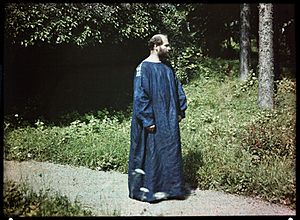
Modern artists continue to be inspired by Klimt. Tawny Chatmon, an American photographic artist, creates portraits of Black children with gold leaf. She was inspired by Klimt's rich portraits of women. The portrait of First Lady Michelle Obama by Amy Sherald also shows influences from Klimt's Portrait of Adele Bloch-Bauer I.
Commemorating his 150th birthday
In 2012, the city of Vienna, Austria, celebrated the 150th anniversary of Klimt's birth. There were special exhibitions and guided tours to see places where Klimt worked.
Google also honored Gustav Klimt with a special Google doodle on his 150th birthday, July 14, 2012. It featured his painting The Kiss. The Austrian Mint also started a series of gold coins to mark this anniversary.
Art restitution and legal battles
Some of Klimt's paintings were taken by the Nazis during World War II. After the war, there have been efforts to return these artworks to the families who originally owned them.
In 2006, the Austrian National Gallery was asked to return five Klimt paintings to Maria Altmann. Her Jewish family had owned the art before it was stolen by the Nazis. This story was made into a documentary called Adele's Wish and a movie called Woman in Gold, starring Helen Mirren. These five paintings were later sold for over $327 million.
In 2021, France announced that a Klimt painting in its national collection, Rosebushes Under the Trees, was also Nazi loot. It was to be returned to the family of Nora Stiasi, who was forced to sell it before she was killed by the Nazis.
These cases show the ongoing effort to return art that was stolen during difficult times.
See also
 In Spanish: Gustav Klimt para niños
In Spanish: Gustav Klimt para niños
- Bride of the Wind (biopic)
- Gustav Klimt's list of paintings
- Japonism
- Klimt Villa
- Lost artworks
- List of Austrian artists and architects
- List of claims for restitution for Nazi-looted art
- Portrait of Adele Bloch-Bauer I


